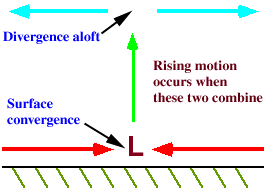|
|
. |
Convergence Associated With Cyclones
extra-tropical and tropical cyclones
Both extra-tropical and tropical
cyclones, like this
hurricane,
can cause air to rise. This type of lifting
is different from the lifting produced along
frontal boundaries.
[Image: hurricane picture (68K)]
Image by: the
GOES Project
In hurricanes,
condensation occurs through
a process known as CISK
(Convective Instability of the Second Kind). We will demonstrate CISK by
referring to the animated cross-section through a mature hurricane given below.
In CISK, surface convergence (pink horizontal arrows)
causes rising motion around a surface
cyclone (labeled as "L").
The air cools as it rises (red vertical arrows)
and condensation occurs, which releases
latent heat into the atmosphere. This heating
causes air to expand, creating an area of
high pressure aloft. The
force resulting from the established
pressure gradient
causes air to diverge at upper levels (red horizontal arrows).
[Image: hurricane (25K)]
Animation by:
Shao
Since pressure
is a measure of the weight of the air above a unit area,
removal of air at upper levels subsequently reduces pressure at the surface.
A further reduction in surface pressure leads to increasing
convergence (due to an intensified
pressure gradient),
which further intensifies the rising
motion, latent heat release, and so on.
Despite the absence of fronts,
a tremendous amount of lifting
occurs in hurricanes, with intense condensation leading to the development of
deep clouds and heavy
rainfall.
In extra-tropical cyclones,
surface winds are deflected by friction
towards the center of the low pressure system (red "L" below).

Coupled with divergence aloft,
(blue arrows), surface convergence (red arrows)
can generate
rising motion (green arrow) that leads to the
condensation of water vapor.

convection
|
|

fronts
|
|


